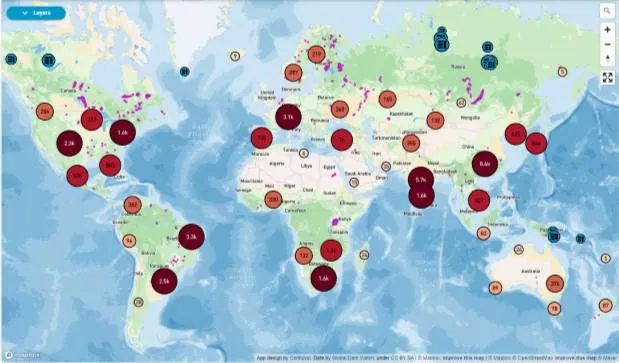Despite delivering many benefits, dams can negatively affect land and water ecosystems, and the species and societies that depend upon them. For humans, an area of land upstream of a dam is often lost to flooding, which can lead to loss of homes or livelihoods, whilst communities downstream of a dam may find themselves suffering water shortages or intermittent supplies. For nature, dams can impede the natural movement and distribution of species, such as migrating fish, whilst changes in water flow can disturb filter feeding species.
Professor of Physical and Environmental Geography, Mark Mulligan
08 October 2024
Under Pressure: New database aims to improve understanding of the impacts of dams and reservoirs
With an explosion in hydroelectric dam and reservoir building expected over the coming decades, a new tool jointly developed at King’s aims to help researchers understand the impacts on people and planet.

A new online tool that integrates global data on dams and other river barriers has been launched, allowing scientists to perform comprehensive, large-scale studies into their impacts.
The Global Dam Watch database contains details of more than 41,000 dams and other artificial barriers which have, in total, created reservoirs covering an area of water the size of Italy.
The majority of the world’s largest dams have been built in just the last sixty years – mainly to provide electricity or irrigation – and whilst their benefits are obvious, their downsides are still not well understood, according to Professor of Physical and Environmental Geography, Mark Mulligan.

About half of all large dams worldwide were built primarily to provide irrigation for farmland, and they support 12–16% of global food production.
Dams also contribute about 70% of the world’s renewable energy production through hydropower.
With global food and energy demands expected to rise by 70% by 2050, it is inevitable that more and larger dams will be built in the coming years.
The need for food and energy is growing especially quickly in low income countries where fewer dams have been built to date, resulting in increased planning and construction of dams in such regions. Their positive and negative impacts on humans and wildlife are also likely to be greatest in such places.
The database has been developed by Global Dam Watch is a consortium of five leading partners - (McGill University, King’s College London, Tübingen University, World Wildlife Fund and the European Commission’s Joint Research Centre) - and a range of collaborators, which aims to improve understanding of the costs and benefits of dams by providing open access data and tools focused on dams and reservoirs.
The key databases that have been integrated include King's GOODD dam database, which maps all 38,000 dams visible on Google Earth satellite imagery.
It is crucial for better planning, management, impact analysis and emergency response to have open-access, accurate and up-to-date information on dam and reservoir characteristics and geographical distribution, says Professor Mulligan.
“The Global Dam Watch database aims to address this issue by bringing together existing global datasets to create a single, globally consistent repository of in-stream barriers and reservoirs and their attributes.”
The paper explaining the database is published today in the journal Scientific Data and is led by Prof Bernhard Lehner of McGill University and co authored by Prof Mark Mulligan and Dr Arnout van Soesbergen from King's Geography, and others from the Global Dam Watch consortium.
Lehner, B., Beames, P., Mulligan, M. et al. The Global Dam Watch database of river barrier and reservoir information for large-scale applications. Sci Data 11, 1069 (2024).
Read the paper here



